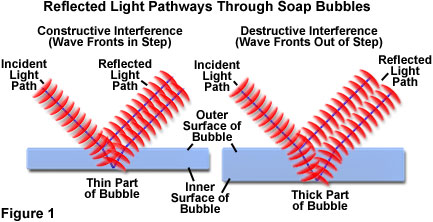Interactive Java Tutorials
Interference Phenomena in Soap Bubbles
Most of us observe some type of optical interference almost every day, but usually do not realize the events in play behind the often-kaleidoscopic display of color produced when light waves interfere with each other. One of the best examples of interference is demonstrated by the light reflected from a film of oil floating on water. Another example is the thin film of a soap bubble, which reflects a spectrum of beautiful colors when illuminated by natural or artificial light sources. This interactive tutorial explores how the interference phenomenon of light reflected by a soap bubble changes as a function of film thickness.
The tutorial initializes with a series of red crescent-shaped incident wavefronts impacting the surface film of a soap bubble, and then being refracted from both the upper and lower air-soap interfaces of the bubble. The thickness of the soap bubble can be adjusted using the Surface Thickness slider to render the parallel, refracted wavefronts either in phase or out of phase. When the wavefronts are in phase, they interfere constructively to produce white light reflected from the Bubble of Uniform Thickness, displayed on the right-hand side of the tutorial window. Alternatively, when the wavefronts are out of phase, they undergo destructive interference to produce a series of colors that is dependent upon the phase relationship between the two wavefronts. In the case where the wavefronts are 180-degrees out of phase, the soap bubble appears black to simulate a total absence of reflected light.
The dynamic interplay of colors often observed on soap bubbles derives from simultaneous reflection of light from both the inside and outside surfaces of the bubble. The two surfaces are very close together (separated by only a few micrometers) and light reflected from the inner surface interferes both constructively and destructively with light reflected from the outer surface. The effect is observed because light reflected from the inner surface of the bubble must travel farther than light reflected from the outer surface, and variations in the soap film thickness produce corresponding differences in the distances light waves must travel to reach our eyes.

When the waves reflected from the inner and outer surfaces of the soap film recombine, they will interfere with each other to either remove or reinforce some wavelengths of white light by destructive or constructive interference (as illustrated in Figure 1). The result is a dazzling display of color that seems to gyrate along the surface of the bubble as it expands and contracts with wind currents. Simply turning the soap bubble, or moving it closer or farther away, causes the colors to change, or even disappear altogether. If the extra distance traveled by the light waves reflected from the inner surface is exactly equal to the wavelength of those bouncing away from the outer surface, then the light waves will recombine constructively to form bright colors. In areas where the waves are out of step with each other, even by some fractional portion of a wavelength, destructive interference effects will begin to occur, attenuating or canceling the reflected light (and the color).
Contributing Authors
Matthew J. Parry-Hill and Michael W. Davidson - National High Magnetic Field Laboratory, 1800 East Paul Dirac Dr., The Florida State University, Tallahassee, Florida, 32310.
BACK TO INTERFERENCE OF LIGHT WAVES
